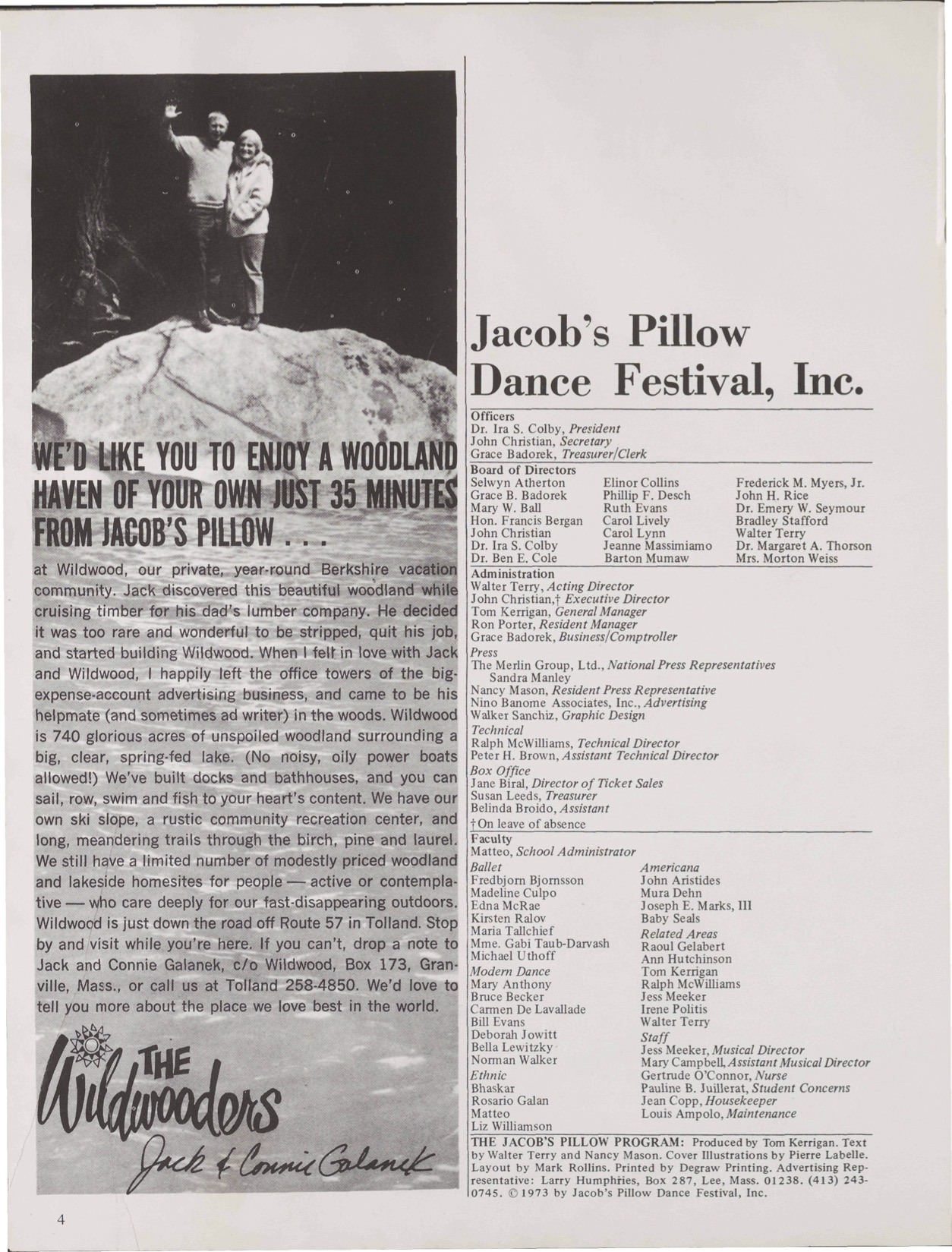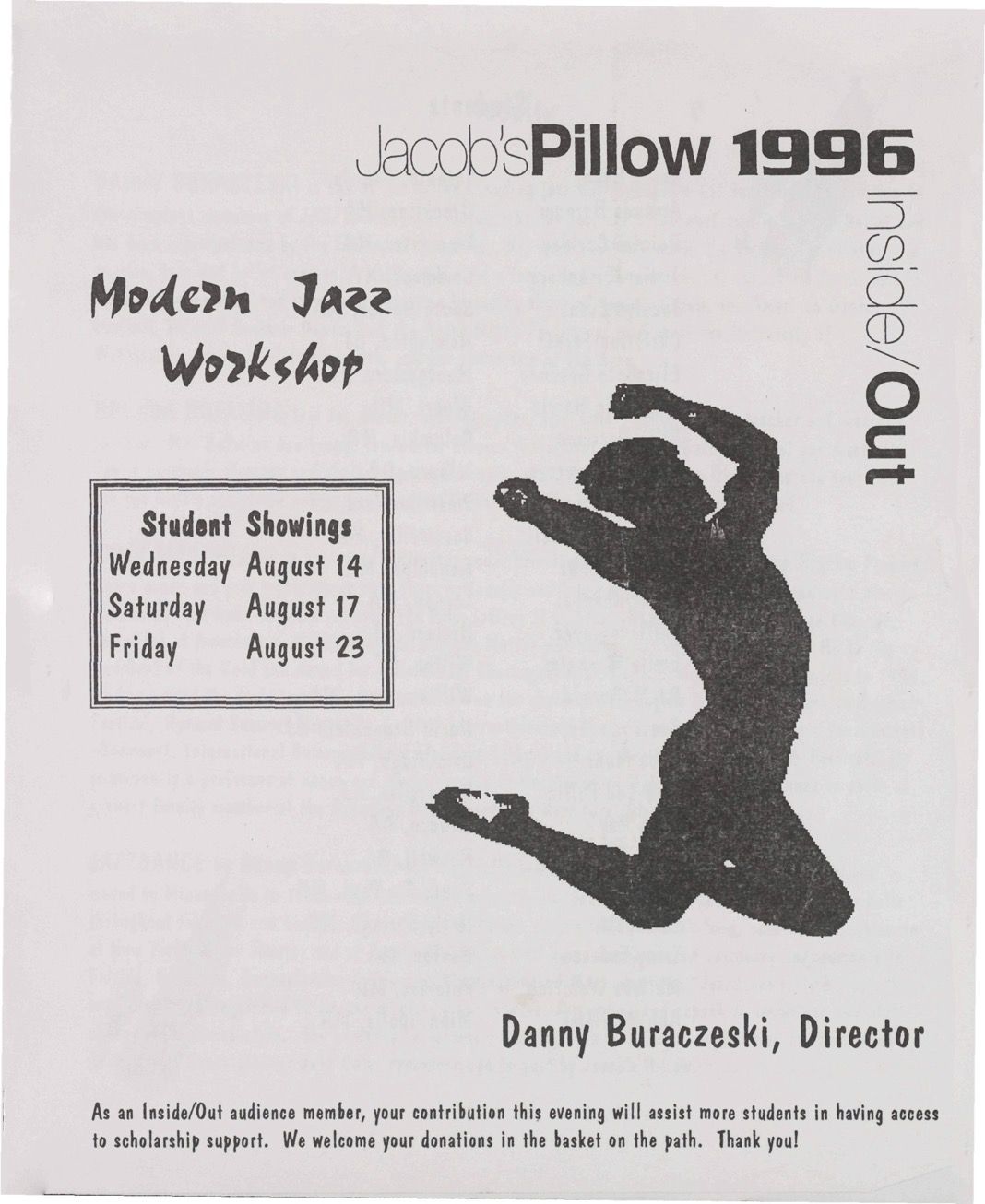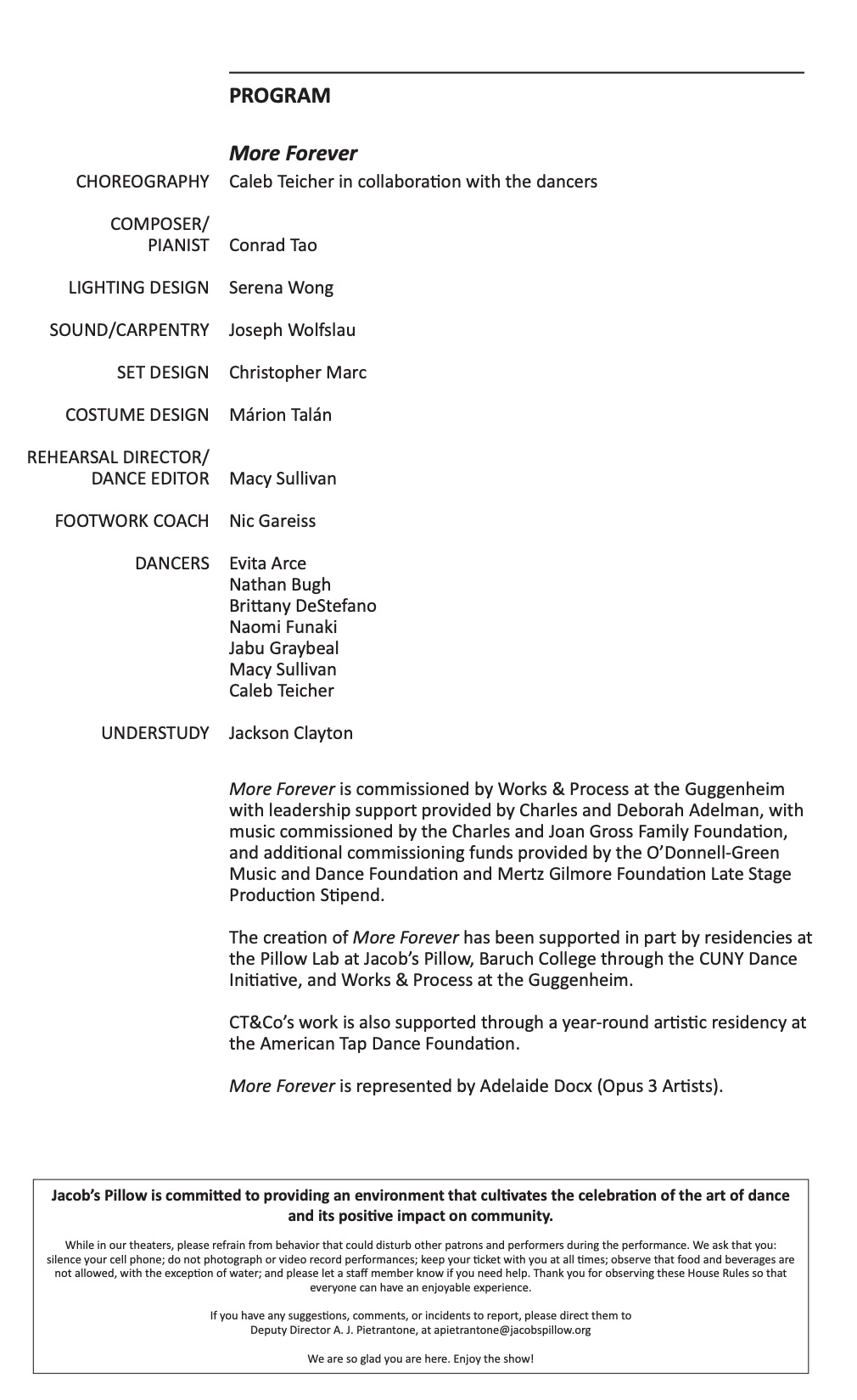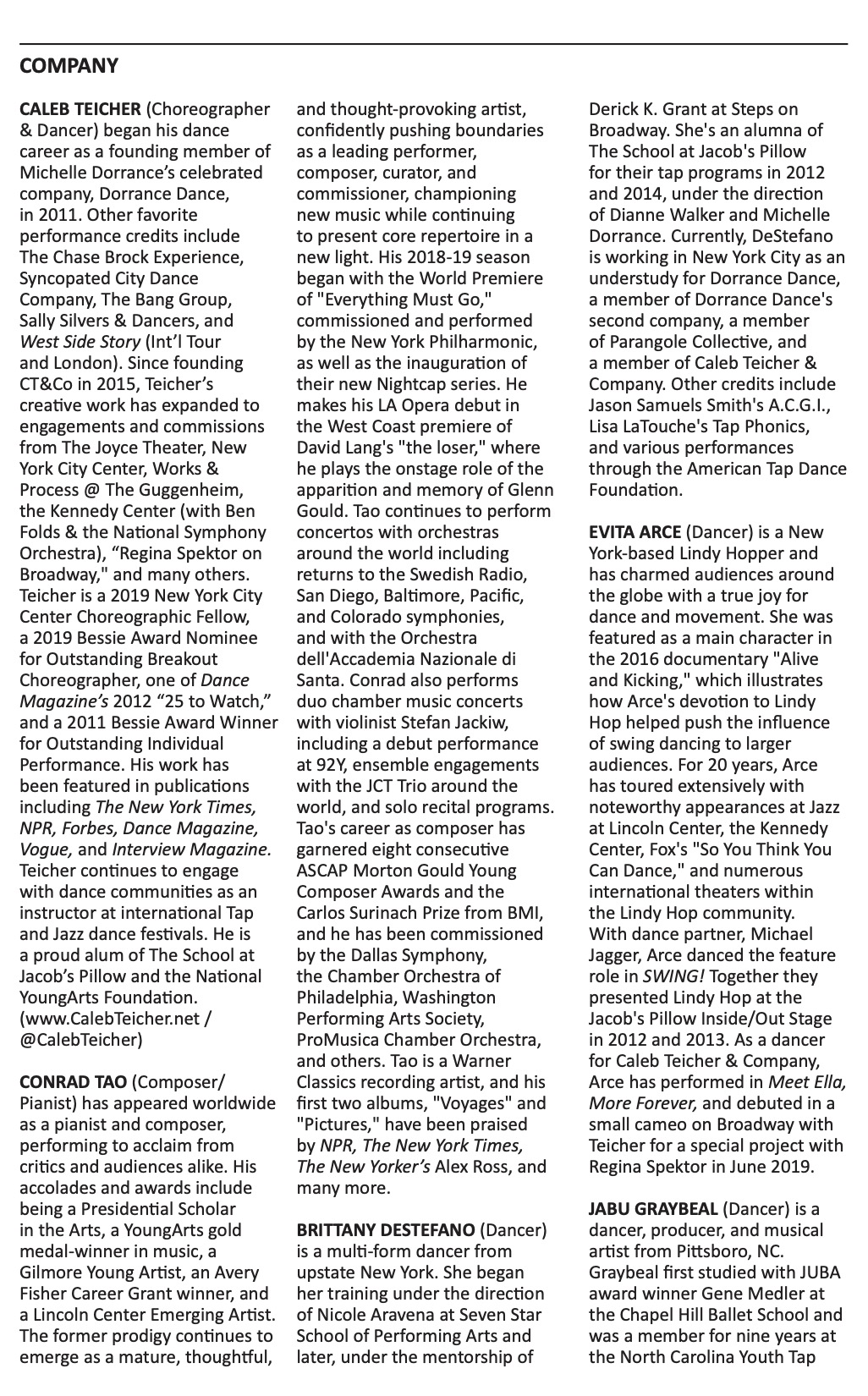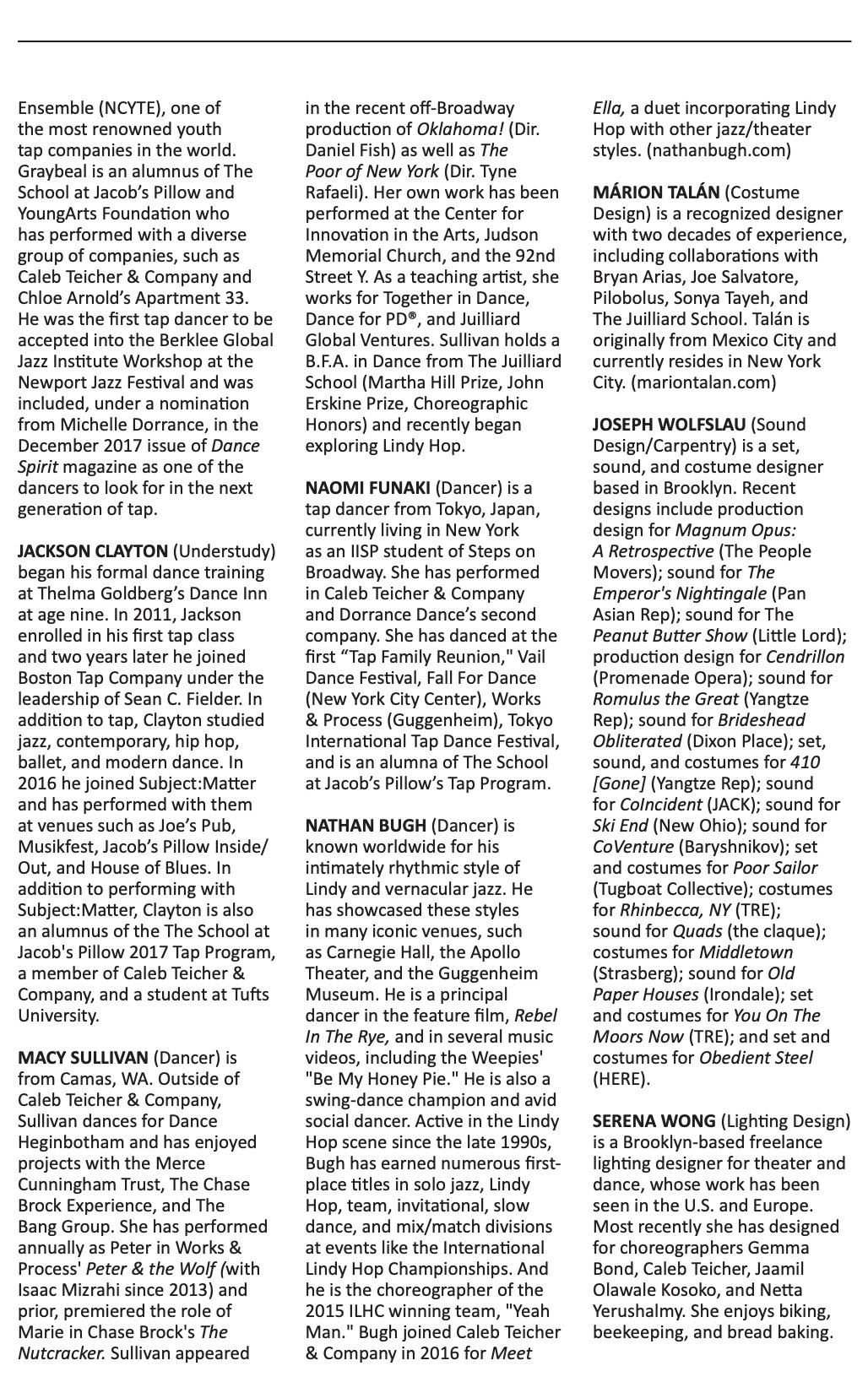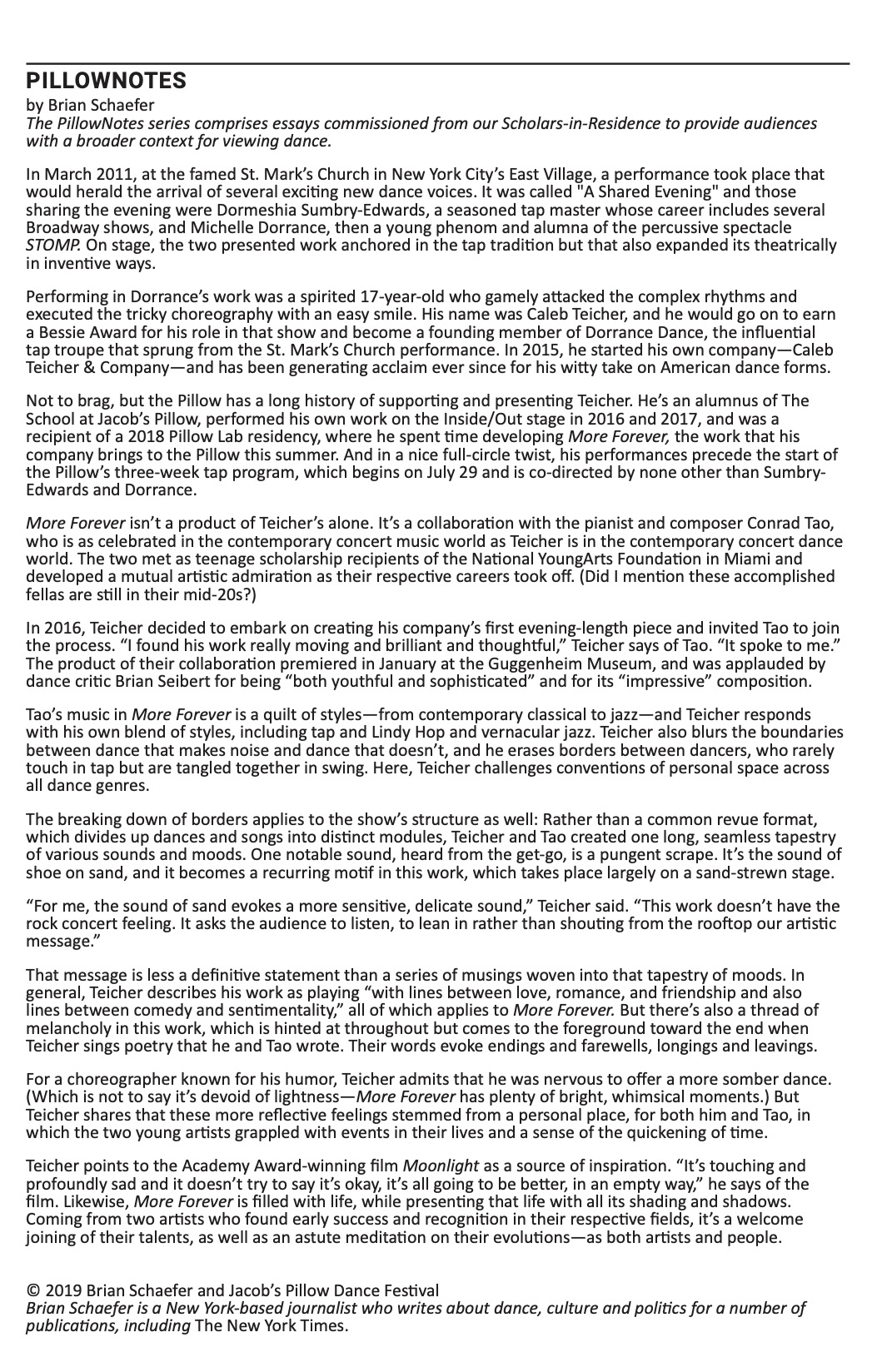Introduction
Jazz dance and jazz music are uniquely American art forms derived from Black American artistry. As dual modes of expression, they were birthed in tandem from enslaved peoples and their descendants, shaped through vaudeville, jook joints, speakeasies, and ballrooms to eventually find homes in social, theatrical, and concert venues. It is fitting that the home to America’s longest running dance festival would have a lengthy history of presenting jazz on stage and within the school. In 1973, Liz Williamson, a noted jazz teacher and former dancer with the Alvin Ailey American Dance Theatre, was the first artist-in-residence at the Jacob’s Pillow Dance Festival. During her residency, she choreographed The Many Faces of Jazz for a cast of sixty-five dancers.“Liz Williamson, 76, Jazz Dance Authority.” New York Times. Accessed March 1, 2019. https://www.nytimes.com/1996/01/13/arts/liz-williamson-76-jazz-dance-authority.html The multiple programs within The School at Jacob’s Pillow have hosted a succession of educators representing leading figures in many styles of jazz dance and its sister form, tap.
A defining characteristic of jazz dance is its relationship to music. The use of music is rarely solely atmospheric. The accompaniment informs choreographic structure, vocabulary, and dynamic choices. Dance is not subservient, nor is it dominant. It is a partnership. Rather than operating independently, as in some post-modern dance methods, dance and music are in conversation, and, when occurring live, adapt to each other to maintain a dynamic of-the-moment dialogue. The origins of this relationship originate from dances of the African diaspora where improvisation is valued and expected. Communication between the dancer and accompanist is willful, and there is often a fluid exchange of these roles. Though the form has evolved and splintered to include influences and sub-genres from other cultures, the fundamental Africanist principles relating to body organization, rhythmic acuity, musical responsiveness, and interpersonal relationships are what make jazz distinct from other Western dance forms.
Jazz Dance and Music
Though jazz was once America’s most popular dance music, the advent of rock ‘n’ roll in the 1950s, with its purposely easy to follow musical structures, marks a parting of ways, as dancers elected to follow the tides of popular culture instead of the increasingly complex and dynamic genres of bebop and free jazz. Though some jazz choreographers continued to work with jazz music in the successive decades, the overall trajectory of jazz dance from the 1960s forward reflects the evolution of popular dance music in America.
In his 1990 article for Dance Teacher Now magazine titled “If Jazz Dance, Then Jazz Music”Billy Siegenfeld “If Jazz Dance, Then Jazz Music.” Dance Teacher Now, August 1990, 50-54. Jump Rhythm Jazz Project founder and Jacob’s Pillow guest faculty member Billy Siegenfeld discusses the divide between the art forms. Siegenfeld promotes the reconciliation of jazz dance and jazz music for the development of sophisticated musicality, and the importance of learning to swing for the virtuosic jazz dancer. He writes, “this yoking of rock music and jazz movement constitutes a paradox. I am interested in challenging this practice and in celebrating rather than denying the necessity for choreographic jazz movement to swinging jazz music.”
The concept of swinging refers to the use of syncopation to create the sense of a lilting groove in the rhythmic structure of a phrase. This is not to be confused with Swing music, the genre of jazz music most popular in the 1930s and 40s. Swing music swings, but so too do the blues, funk, bebop, and r&b. The styles of jazz dance created in tandem with this music—authentic jazz, tap, and funk, among others—also swing. In rock and pop music, the lack of this pendulum-like syncopation produces a sense of squared evenness in the music; a feeling at odds with swinging, which is defined by a steady irregularity. This overall academic explanation should not eclipse the fact that swing is meant to be felt. For dancers, it is instinctual.
Katherine Dunham & Cleo Parker Robinson Dance Ensemble
In this 1996 performance of Katherine Dunham’s Barrelhouse (1938) by Cleo Parker Robinson Dance Ensemble, we see an early incarnation of social jazz dance adapted for the concert stage. Originally created for Dunham’s production Tropics and Le Jazz Hot: From Haiti to Harlem, the movement is based on dancing found in Chicago honky tonks of the early 20th century. However, Dunham’s is a theatricalized version, owing as much to Broadway’s proscenium staging as it does to social dance. Here the sense of swing is unhurried. Performed by Robinson and Randy Brooks to the music of Jess Stacy, in this mid-tempo piece body meets boogie as meeting turns to mating. Dunham’s choreography reflects the intimacy of the small band’s blues by focusing on isolations and repetition, with the swinging located in the hips, shoulders, and limbs. The dancers alternate between complementing the rhythm section and following the lead of the solo piano and trumpet.
Danny Buraczeski
Danny Buraczeski’s choreography for the students in The School at Jacob’s Pillow displayed a commitment to maintaining the bond between jazz dance and music from jazz, gospel, blues, and funk traditions. Students in the 1997 Fresh Perspectives of Jazz Workshop performed to the music of Mahalia Jackson, Horace Silver, Wynton Marsalis, and Celia Cruz, among others. In Buraczeski’s introduction to the workshop performance, he emphasizes the critical role jazz music serves in the curriculum, likening the program to an “oasis in the desert” of pop culture where he rarely encounters jazz music. Buraczeski’s comments presage present-day concerns in the field about the ongoing use of the term jazz to describe contemporary dancing with tenuous bonds to the roots of the form. Decades later, Jacob’s Pillow guest faculty member E. Moncell Durden writes of this same conundrum noting, “At its inception, jazz dance is first and foremost motivated by the music… Many jazz classes are using pop music, house music or rock music, which does not provide the energy, spirit or feel of the movement created to jazz music.”Moncell Durden, “The Morphology of Afro-Kinetic Memory: A Provocative Analysis of Marginalized Jazz Dance,” in Rooted Jazz Dance: Africanist Aesthetcis and Equity in the Twenty-First Century (Florida: University Press of Florida, 2021) 64.
Though there are now even fewer jazz ‘oases’ than during Buraczeski’s era, the Jacob’s Pillow Archives showcase a host of artists with a strong commitment to the marriage of jazz music and dance, providing an excellent primer to varied approaches to dancing to jazz music, and the importance of swing.
LaTasha Barnes
The great big band leader Count Basie once said “a band can really swing, when it swings easy. When it can play along like cutting butter, even a single note can swing.”Count Basie, “Good Morning Blues, The Autobiography of Count Basie, E-book ed.; (Minnesota: University of Minessota Press, 1985), 612. In this excerpt from LaTasha Barnes presents The Jazz Continuum (2021), the dancing ensemble is a visual representation of the accompaniment’s laid-back groove. As they dance to Charles Turner’s Harlem Harlem Harlem, the sense of swing is highly visible in their bodies. Limbs fly to and fro echoing the bleating horns, as feet tap out soft shoe rhythms with the ease and confidence of the walking bass line heard throughout the tune. Literally leaning into the band and vocalists’ groove, the weight of the pendulum is an accent in the phrasing, and a tool of expressivity which pushes the suspension of duration as to almost be late, but never out of time.
Barnes adapted this choreography from Norma Miller and Chester Whitmore’s The Queen Swings Basie (a version of the lindy hop routine known as Trickeration). The dancers represent a range of Black American social dance traditions from lindy hop and hustle to locking, house, and waacking (i.e., The Jazz Continuum), simultaneously placing them in the past and present. In this performance you see slightly differing inflections of accent and flourish in relation to the down and up beats. Theirs is a social endeavor in which the sense of swing is the glue tethering their varied interpretations together. While a shared sense of rhythm and groove is the point, uniformity is not the goal.
Lee Howard
A conversation about jazz dance and music would be incomplete without touching down on tap dance. The fraternal twin of authentic jazz dance, there was a time when jazz and tap were virtually indistinguishable. Tap dancers often performed in musical revues with the great jazz bands of the early-mid 20th century. Cab Calloway, Count Basie, and Jimmie Lunceford, among others, all featured tap dancers on their tours. It was a logical pairing, as the musicians and dancers shared improvisation and rhythm as the base from which the art making sprung. Jazz drummers were often influenced by the syncopation and sound variety from tap dancers, and, in some cases, the drummers also danced. Louis Bellson, Duke Ellington’s drummer, shared that the greatest drum solo he ever heard was by Bill Bailey the tap dancer.Jaqui Malone, “Jazz Music in Motion” in Steppin’ On The Blues: The Visble Rhythms of African American Dance (Illinois: University of Illinois Press, 1996), 95.
Following in the grand tradition of live jazz music with tap, Jason Samuels Smith’s 2009 ensemble A.C.G.I. (Anyone Can Get it) performed with a standard ensemble of piano, bass, and, in place of the standard drum kit, congas played by his father, famed jazz dance teacher and percussionist Jo Jo Smith.
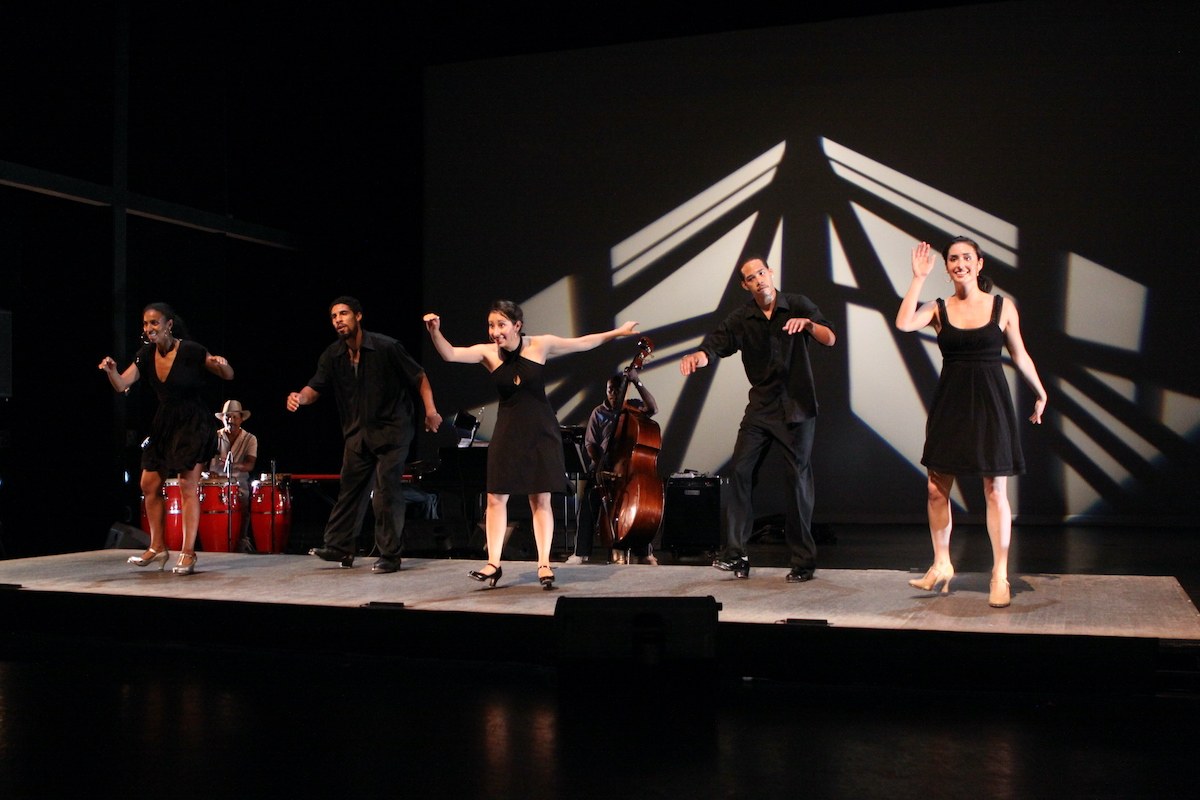
In this excerpt from the performance, Lee Howard dances to one of the swingingest tunes of all time, John Coltrane’s “Giant Steps.” As the band segues from Coltrane’s composition to a rendition of Stevie Wonder’s “I Can’t Help It,” notice how Howard’s relationship to the music shifts. The accompaniment transitions from emphasizing Coltrane’s modal chords to Wonder’s love of melody. Accordingly, Howard’s relationship also morphs from soloing on top of the chords to joining the rhythm section of the ensemble. The shift from straight ahead jazz to lilting r&b inspires a different approach to swinging, and his transition is seamless and masterful. While Howard’s rhythms are still highly intricate during “I Can’t Help It,” it is embedded within the music composition rather than using the tune as a launch pad to the rhythmic stratosphere, as one does with “Giant Steps.” In this performance, you may notice how Howard turns his body toward the bassist much in the way a drummer would, to connect as the groove changes for the rhythm section. Once contact has been established, he takes off again, securely in the pocket of the groove.
Caleb Teicher
The music for Caleb Teicher & Company’s More Forever was commissioned for the dance. Composed and performed live by pianist Conrad Tao, the music, like Teicher’s blend of tap and lindy hop, lives between worlds, neither wholly classical, jazz, nor new music. Teicher’s choreography swings with the music, but not because of it. The movers are the keepers of the groove, while the music often dances around them. Sometimes it is a game between the two.
Dancers are further challenged to maintain a sense of swing while navigating the fluid changes in the music’s meter as it rapidly shifts between musical measures of varying length. It should be noted that Teicher and company are also improvising within the choreography and dancing on sand throughout the performance. The complex music is but one of many obstacles they choose to tackle in More Forever. In the post-show discussion, Teicher commented on the world they created with the dancers, Tao, and the sand, stating “In order to connect you have to let go of what you’re holding on to… There’s no scarcity—there’s just space for all.” In their approach to musicality, Teicher noted that the dancing in this piece is melodic in more ways than is some of their earlier work, due to the influence of Irish percussive dancer Nick Gareiss, who coached the dancers during the rehearsal process. The end result is a work that’s fantastical—aurally and visually. Rhythmic, airy, and swift, it constantly shifts like the sand upon which they dance.
Conclusion
While distinctly different in aesthetic, the work of Katherine Dunham and Cleo Parker Robinson Dance Ensemble, Danny Buraczeski, LaTasha Barnes, Lee Howard, and Caleb Teicher all sit under the large family tree that is jazz dance. Each artist occupies a different branch, representing different styles. Like its musical sibling, jazz dance is a varied form with multiple approaches, value systems, and training methods. A common denominator among their choreographic voices is a purposeful relationship to music. Each artist allows the cadences and dynamics of the accompaniment to inform choreographic choices. The complexity of jazz (and jazz adjacent) music encourages choreographic invention. The emphasis on syncopation and the range of textures in the accompaniment allows for creative freedom, while also reinforcing the fundamental principle of swing. For many decades, audiences and students at the Pillow have benefited from this confluence of jazz dance styles that simultaneously represents the artistic concerns of masters of the form, while also occupying a rarified space within the aesthetics of jazz dance that is unique when compared to popular trends within contemporary jazz.

